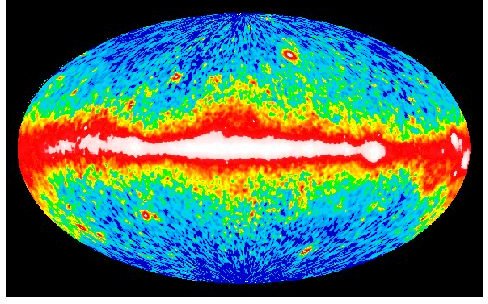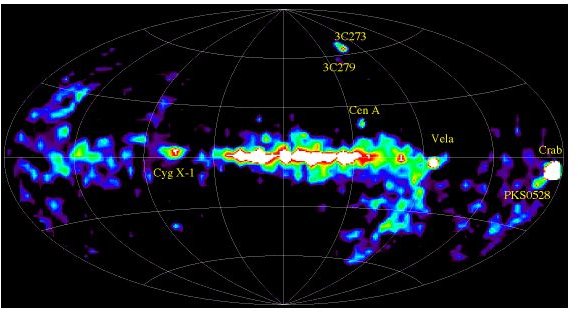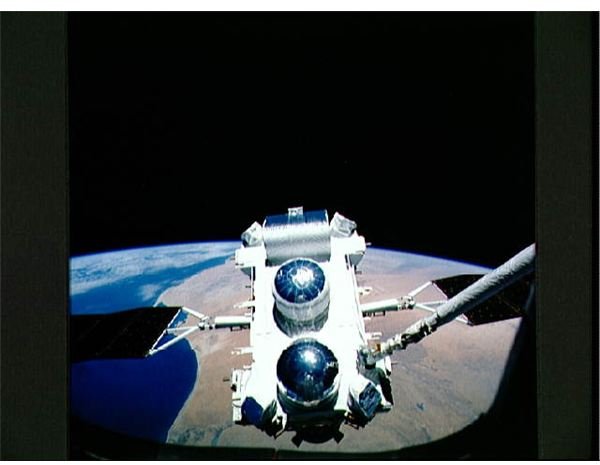The Compton Gamma Ray Observatory: History & Discoveries
Gamma rays. Even just the name of this part of the electromagnetic spectrum has an exotic feel to it. At the time of the Compton Gamma Ray Observatory’s launch, gamma ray astronomy was in its infancy, with no real observational power and no real data. While Compton is no longer in operation, this telescope has made a deep impact into the field of both gamma ray astronomy and astronomy in general. Check out this article for an overview of Compton’s history, specs, and discoveries.
Images of Compton

Genesis
Compton was the second of NASA’s “Great Observatories”, one of four including Hubble, Chandra and Spitzer. It was launched in 1991 weighing in at 17 tons, the heaviest payload of its time. Compton was long awaited and much needed: its instruments provided an increase in sensitivity by nore than a factor of ten, and could peer into a range of gamma ray light that no other observatory previously could.
The Compton Gamma Ray Observatory was named after Dr. Arthur Holly Compton, who won a Nobel Prize for his work in gamma ray physics—science which rendered the technology of the telescope possible.
Compton Surveys


How Compton Worked
Gamma rays pass right through mirrors, so unlike most other observatories for different wavelengths, this observatory had to use the Compton scattering effect to detect and map out high-energy gamma rays. Essentially, Compton scattering consists of when x-rays interact with ordinary matter, thus losing energy. Check out this NASA article for an explanation of how Compton scattering works for telescopes.
From here, it operated four different instruments that covered a huge portion of the electromagnetic spectrum, from 20 keV to 30 GeV - a one eV or electron volt being a unit of energy gained by an electron, which is accelerated through a potential of 1 volt, roughly equivalent to 1.6 x 10-19 Joules.
They included the BATSE, the Burst and Transient Source Experiment, which conducted full sky experiments; the OSSE, the Oriented Scintillation Spectrometer Experiment, which would do point observations of both source and background noise; the COMPTEL, the Imaging Compton Telescope; and the EGRET, the Energetic Gamma Ray Experiment Telescope, a wide field telescope that specialized in more high energy gamma rays.
Compton was set at a very low orbit, a mere 450 km, to just duck under the Van Allen radiation belt.
Discoveries Through Compton
Compton is responsible for the first all-sky surveys in the gamma ray spectrum, resulting in the discovery of more than 170 unidentified gamma ray sources. It also completed the first gamma ray survey of the galactic core (see above), during which it discovered a possible antimatter cloud in orbit right above the center. More than 2700 gamma ray bursts were recorded, averaging one per day.
As far as specific discoveries go, Compton was entirely responsible for soft gamma ray repeaters, short duration, unpredictable sources that had previously been impossible to detect. Gamma ray repeaters in general also underwent some basic classification as data on them increased due to Compton’s efforts. Here on Earth, gamma ray sources were also recorded in the form of our own thunderstorms.
For more information, check out Compton’s observation timeline.
Compton’s Crash Landing
You’ve probably noticed by now that this whole article has been written in the past tense. It’s hard to believe that all of this happened during a mere nine year mission, but Compton is long gone. The cause? A gyroscope within Compton failed in 2000, which helps to steer and maneuver the spacecraft. While all the observational instruments were still running perfectly, and limited maneuverability was still possible, the broken gyroscope presented a danger. Compton could have fallen at any time into the atmosphere and crashed into human settlements, which is not exactly most people’s idea of a safe end to a mission. So, on June 4, 2000, NASA deliberately deorbited the telescope, allowing most of it to burn up during reentry and what was left of it to crash safely into the Pacific Ocean.
